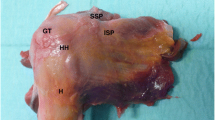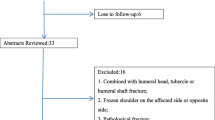Abstract
Introduction
The purpose of this study is to compare the clinical and radiological outcomes of patients undergoing open reduction and internal fixation (OR/IF) using a plate or patients undergoing an arthroscopic suture anchor fixation for the greater tuberosity (GT) fracture of the proximal humerus. The purpose of this study is to compare the clinical and radiological outcomes of patients undergoing OR/IF or an arthroscopic suture anchor fixation for the GT fracture.
Materials and methods
Between January, 2010 and December, 2020, 122 patients with GT fracture underwent operative fixation. Either OR/IF using proximal humeral locking plate (50 patients) or arthroscopic suture anchor (72 patients) fixation was performed. Fourteen patients were lost to follow-up and finally, 108 patients were enrolled in this study. We divided these patients into two groups: (1) OR/IF group (Group I: 44 patients) and arthroscopic anchor fixation group (Group II: 64 patients). The primary outcome was subjective shoulder function (shoulder functional scale). Secondary outcomes were range of motion, and complications including GT fixation failure, fracture migration, or neurologic complication. Also, age, sex, BMI, operation time, shoulder dislocation, fracture comminution, AP (anteroposterior), SI (superoinferior) size and displacement were evaluated and compared between two groups.
Results
Both groups showed satisfactory clinical and radiological outcomes at mid-term follow-up. Between 2 groups, there were no significant differences in age, sex, BMI, presence of shoulder dislocation or comminution. Group II showed higher clinical scores except VAS score (p < 0.05) and longer surgical times (95.3 vs. 61.5 min). Largest fracture displacement (Group I vs. II: SI displacement: 40 vs. 13 mm, and AP displacement: 49 vs. 11 mm) and higher complication rate (p = 0.049) was found in Group I.
Conclusions
Both arthroscopic anchor fixation and open plate fixation methods showed satisfactory outcomes at mid-term follow-up. Among them, OR/IF is preferred for larger fracture displacement (> 5 mm) and shorter operation time However, arthroscopic anchor fixation group showed better clinical outcomes and less complications than the OR/IF group.
Level of evidence
Level 4, Case series with subgroup analysis.








Similar content being viewed by others
References
Rouleau DM, Mutch J, Laflamme GY (2016) Surgical treatment of displaced greater tuberosity fractures of the humerus. J Am Acad Orthop Surg 24:46–56. https://doi.org/10.5435/jaaos-d-14-00289
Court-Brown CM, Garg A, McQueen MM (2001) The epidemiology of proximal humeral fractures. Acta Orthop Scand 72:365–371
Robinson CM, Shur N, Sharpe T et al (2012) Injuries associated with traumatic anterior glenohumeral dislocations. J Bone Joint Surg Am 94:18–26. https://doi.org/10.2106/jbjs.j.01795
Green A, Izzi J Jr (2003) Isolated fractures of the greater tuberosity of the proximal humerus. J Shoulder Elbow Surg 12:641–649
Kokkalis ZT, Iliopoulos ID, Antoniou G et al (2017) Posterior shoulder fracture-dislocation: an update with treatment algorithm. Eur J Orthop Surg Traumatol 27:285–294. https://doi.org/10.1007/s00590-016-1840-5
White EA, Skalski MR, Patel DB et al (2018) Isolated greater tuberosity fractures of the proximal humerus: anatomy, injury patterns, multimodality imaging, and approach to management. Emerg Radiol 25:235–246. https://doi.org/10.1007/s10140-018-1589-8
Flatow EL, Cuomo F, Maday M et al (1991) Open reduction and internal fixation of two-part displaced fractures of the greater tuberosity of the proximal part of the humerus. J Bone Joint Surg Am 73:1213–1218
Keener JD, Parsons BO, Flatow EL et al (2007) Outcomes after percutaneous reduction and fixation of proximal humeral fractures. J Shoulder Elbow Surg 16:330–338
Yoon T-H, Choi C-H, Choi Y-R et al (2018) Clinical outcomes of minimally invasive open reduction and internal fixation by screw and washer for displaced greater tuberosity fracture of the humerus. J Shoulder Elbow Surg 27:e173–e177
Ji J-H, Kim W-Y, Ra K-H (2007) Arthroscopic double-row suture anchor fixation of minimally displaced greater tuberosity fractures. Arthroscopy 23(1133):e1131-1133. https://doi.org/10.1016/j.arthro.2006.11.029
Ji J-H, Shafi M, Song I-S et al (2010) Arthroscopic fixation technique for comminuted, displaced greater tuberosity fracture. Arthroscopy 26:600–609
Park S-E, Jeong J-J, Panchal K et al (2016) Arthroscopic-assisted plate fixation for displaced large-sized comminuted greater tuberosity fractures of proximal humerus: a novel surgical technique. Knee Surg Sports Traumatol Arthrosc 24:3892–3898
Seppel G, Saier T, Martetschläger F et al (2017) Single versus double row suture anchor fixation for greater tuberosity fractures—a biomechanical study. BMC Musculoskelet Disord 18:1–7
Kim DR, Noh Y-M, Lee SY (2019) Arthroscopic reduction and suture bridge fixation of a large displaced greater tuberosity fracture of the humerus. Arthrosc Tech 8:e975–e985
Duralde XA (2016) CORR Insights®: is arthroscopic technique superior to open reduction internal fixation in the treatment of isolated displaced greater tuberosity fractures? Clin Orthop Relat Res 474:1280–1282. https://doi.org/10.1007/s11999-016-4702-x
Liao W, Zhang H, Li Z et al (2016) Is arthroscopic technique superior to open reduction internal fixation in the treatment of isolated displaced greater tuberosity fractures? Clin Orthop Relat Res 474:1269–1279. https://doi.org/10.1007/s11999-015-4663-5
Ji J-H, Jeong J-J, Kim Y-Y et al (2017) Clinical and radiologic outcomes of arthroscopic suture bridge repair for the greater tuberosity fractures of the proximal humerus. Arch Orthop Trauma Surg 137:9–17
Longo UG, Corbett S, Ahrens PM (2018) Missed fractures of the greater tuberosity. BMC Musculoskelet Disord 19:313. https://doi.org/10.1186/s12891-018-2225-1
Lin CL, Hong CK, Jou IM et al (2012) Suture anchor versus screw fixation for greater tuberosity fractures of the humerus—a biomechanical study. J Orthop Res 30:423–428
Kaisidis A, Pantos PG, Bochlos D et al (2018) Biomechanical analysis of the fixation strength of a novel plate for greater tuberosity fractures. Open Orthop J 12:218
Verdano MA, Aliani D, Pellegrini A et al (2014) Isolated fractures of the greater tuberosity in proximal humerus: does the direction of displacement influence functional outcome? An analysis of displacement in greater tuberosity fractures. Acta Biomed 84:219–228
Tashjian RZ, Shin J, Broschinsky K et al (2020) Minimal clinically important differences in the American Shoulder and Elbow Surgeons, Simple Shoulder Test, and visual analog scale pain scores after arthroscopic rotator cuff repair. J Shoulder Elbow Surg 29:1406–1411. https://doi.org/10.1016/j.jse.2019.11.018
Xu S, Chen JY, Lie HME et al (2020) Minimal clinically important difference of Oxford, constant, and UCLA shoulder score for arthroscopic rotator cuff repair. J Orthop 19:21–27. https://doi.org/10.1016/j.jor.2019.11.037
Funding
There is no funding source.
Author information
Authors and Affiliations
Corresponding author
Ethics declarations
Conflict of interest
The authors declare that they have no conflict of interest.
Ethical approval
This research project has been reviewed and approved by the Institutional Review Board (IRB) of the authors’ affiliated institutions.
Informed consent
Informed consent was obtained from all individual participants included in the study.
Additional information
Publisher's Note
Springer Nature remains neutral with regard to jurisdictional claims in published maps and institutional affiliations.
Rights and permissions
Springer Nature or its licensor (e.g. a society or other partner) holds exclusive rights to this article under a publishing agreement with the author(s) or other rightsholder(s); author self-archiving of the accepted manuscript version of this article is solely governed by the terms of such publishing agreement and applicable law.
About this article
Cite this article
Kim, YJ., Ji, JH., Park, SE. et al. Comparison between arthroscopic suture anchor fixation and open plate fixation in the greater tuberosity fracture of the proximal humerus. Eur J Orthop Surg Traumatol 34, 621–631 (2024). https://doi.org/10.1007/s00590-023-03684-x
Received:
Accepted:
Published:
Issue Date:
DOI: https://doi.org/10.1007/s00590-023-03684-x




